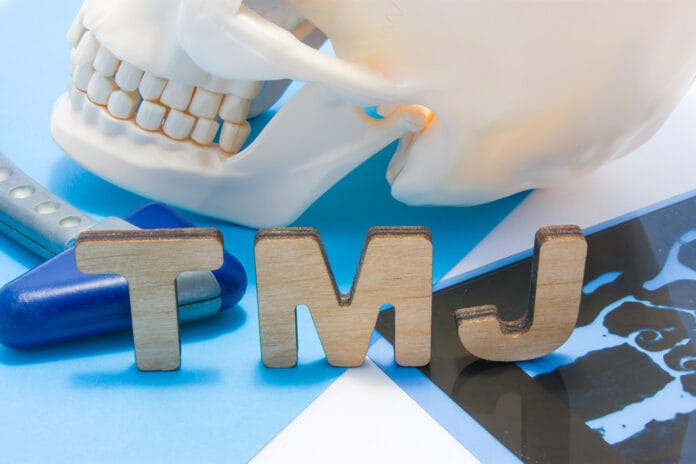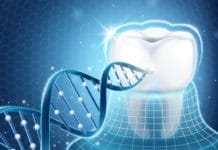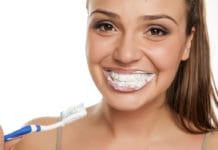I suddenly became my own dental patient one day after years of clicking and popping in my right side temporomandibular joint ‒ nothing painful or even uncomfortable. I just knew that I would feel and hear my jaw when I ate.
For many years, my “normal” jaw included painless popping and clicking, more so when opening. It didn’t keep me from eating, and I didn’t worry about it enough to treat.
Then March 2021 arrived. I woke up one morning, and I couldn’t open my mouth much at all. I struggled to get the toothbrush on my teeth. I thought I must have just slept on it wrong. With an additional feeling of stiffness and caution using the jaw throughout the day, the same thing happened daily for about two weeks ‒ worse in the morning with minimal progress or opening throughout the day.
I tried to think through what I was experiencing. Am I sleeping wrong on my jaw? Is it neck-related? Was my new pillow causing this? Is it hormonal? Am I grinding or clenching more? I ruled out the latter since I do wear a night guard and a retainer. The condition was just on my right side, and my left side felt fine.
Two weeks after the morning of the initial pain, my jaw felt like it was moving all over the place when I ate, drank, yawned, and even swallowed. It felt like it was sliding in, sliding out, popping, clicking, adjusting ‒ like walking in shoes that are too big. I just couldn’t get comfortable. It was awful and very unnerving.
A New Pain Emerges
This lasted for two weeks to the day, then it stopped. It seemed fine and felt as if my jaw was put back into place for the most part. I no longer even had the popping and clicking as I did prior to all this.
A new pain, though, felt mainly localized with stiffness, lack of mobility, flexibility, and rigidity began occurring. I couldn’t pinpoint where the pain originated. My jaw deviated to the right when I opened now, compensating for the lack of movement. I had no idea why my condition drastically changed utterly overnight. When I palpated my cheek, it felt like a muscle knot deep into my masseter.
I tried the advice I typically give patients: Self-massaging it, eating soft foods, ibuprofen/Tylenol, and the ol’ standby of just giving it time. I then tried cold and hot compresses. In addition, I unsuccessfully tried cold laser therapy, chiropractic adjustments, massage therapy with a masseuse who had extra training in TMJ, and Soma muscle relaxers. I switched to Flexeril with minimal results and some relief. It didn’t feel as strained, maybe a 5% improvement.
I tried exercises and stretches of my mouth, jaw, cheek, and neck with very minimal results ‒ maybe another 5% improvement. So now, I had about 10% improvement after this round of home treatments. My cheek muscles relaxed enough to narrow down that the pain was initiated from my temporomandibular joint. I started wondering if the trauma from the adjustments also created arthritis in the TMJ, and this was just my new normal.
I had pain all on the right side of my face. My head persistently ached, and the ear pain was sharp, dull, and throbbing. My right eye hurt, and my upper and lower right teeth were painful. The right side of my nose even felt the misery.
All of these pains are very uncommon for me. It was also a weird feeling; my left side felt perfectly normal.
Another thing was my night guard and retainer were painful to wear. It felt as if pressure was pushing onto my TMJ and having instant relief when I took it out in the morning. When I slept on my side, either side, I could feel the pressure and tension on my jaw, so I tried sleeping on my back.
I couldn’t really eat well. I was pushing food into my mouth rather than biting into the food. It took longer to chew, and the meals consisted of smaller amounts of food. Many times, I even had to pause until a sharp pain subsided.
Turning to a Specialist
My instinct was that I needed a cortisone injection since it felt noticeably stiff from inflammation. I searched for the types of doctors who could treat it. As a dental professional, I wasn’t sure who to see. I wasn’t sure if a TMJ specialist, an orofacial specialist, or a medical doctor was needed. I don’t have dental insurance and wanted to go through my medical insurance to avoid paying so much out of pocket.
So, I delayed. Plus, I thought I could fix it on my own.
Well, I had to start somewhere. I was exhausted from the constant pain. I decided on an orofacial pain specialist first. I wasn’t convinced this was what I needed since the pain was from my TMJ radiated to other parts of the face rather than actual facial pain.
In January 2022, I succumbed and made an appointment with the orofacial pain specialist, who is a dentist. As I explained what happened with my jaw and its history, she nodded like she knew exactly what was going on. Not only did she say this was textbook, but she actually teaches on the subject at the local university. She had a precise name for it: disc displacement without reduction closed.
Signs of Disc Displacement
The articular disc located between the mandible’s condyloid process and the cranium’s mandibular fossa is pushed out of place. The disc is a thin, oval plate made of nonvascular fibrous connective tissue. This causes issues with opening the mouth, popping, clicking, and locking of the jaw joint. If the disc is stuck anterior to the condyle, it is a closed lock without reduction. If it is stuck posterior to the condyle, it is an open lock with reduction.
With my case of open lock without reduction, the early signs were the clicking and popping when opening and with the disc always returning to its normal position between the joints. In the later stages, the disc became displaced and moved itself anteriorly of the condyloid process blocking the full range of motion and the opening process.
I checked many of the common boxes:
- Middle-aged (young to middle age)
- A woman (twice as common in women than men)
- History of popping and clicking
- Deflection of the mandible to the affected side when opening
- Restriction of movement on the affected side
- Mouth opening measured less than 40 mm (mine was at 38mm)
- Knew exactly when the closed lock occurred, as the pain came on suddenly
- Sharp sudden and intense pain to the joint
- With inflammation present, the pain was dull and throbbing at rest and intensified with movement.
- Pain was felt in the head, ear, teeth, and facial
- Occlusion was off where my teeth didn’t touch right1
Treatment
The orofacial specialist measured my mouth opening with an initial measurement of 38 mm. One reason I chose this dentist was that she does cortisone injections, which I self-diagnosed that I probably needed, and she agreed. Before the injection, she adjusted my maxillary night guard as my bite was hitting on the right side.
She did a quick injection of lidocaine at the TMJ in front of my right ear. Then she injected Kenalog. Pressure was instantly experienced on the right side TMJ area. I couldn’t open my mouth; it was that stiff. In comparison, an ankle sprain is tight, swollen, and hard to move or use. The dentist waited a few minutes for it to kick in, then stretched my jaw by pulling down the mandible and pulling up on the maxillary.
We heard a pop, and I felt instant relief that was gratifying and pleasing. It was like finally scratching that hard-to-reach itch or releasing a stubborn muscle knot. Once it’s liberated, there’s instant tranquility. During the procedure, my body started sweating from the quick, intense pain of releasing the disc. My final measurement ended at 49 mm, close to the normal 50 mm.
Post-Treatment
This treatment could resolve the issue or just improve it. No follow-up treatment is required 90% to 99% of the time, and the issue is resolved with no increased risk of recurrence. Also, the doctor eased my mind about an increased chance for arthritis as there is none compared to someone who hasn’t had this procedure.
Side effects are possible with pain during the next few days until the corticosteroid fully kicks in. There may be a possible drooping of the face within the first hour (which did not happen with me). Although the pain was gone instantly, I still felt a little tug when I yawned after the first few weeks, but that has since subsided.
The best part is that I no longer push food into my mouth. I can actually bite into a burger now. I can fully yawn, and I no longer have head pain. I hope my experience is a good reminder for dental clinicians not to brush off patients’ TMJ clicking and popping. Through my experience, I would recommend having it resolved sooner to prevent months of unnecessary discomfort.
Now Check Out the Peer-Reviewed, Self-Study CE Courses from Today’s RDH!
Listen to the Today’s RDH Dental Hygiene Podcast Below:
References
- Klasser, G., Epstein, J. How to Manage “Closed Lock” Disc Displacement Without Reduction with Limiting Opening. J Can Dent Assoc. 2014; 80: e60. https://jcda.ca/article/e60










